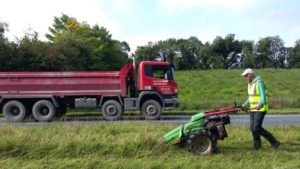
Ulster Wildlife is the lead Save Our Magnificent Meadows partner in County Fermanagh, supported by a steering group of interested parties.
In County Fermanagh, Save Our Magnificent Meadows focuses on purple-moor grass/rush pasture, which is deteriorating in extent and quality, and on lowland meadows and their associated species, for which County Fermanagh is one of the main strongholds of lowland meadow in Northern Ireland.
Save our Magnificent Meadows has delivered significant benefits to this lovely region, including the highlights listed below.
– From a standing start, we have energised and engaged the local voluntary sector, who have in turn provided hundreds of hours of free time and transformed the fortunes of key meadows such as Monastery and Garrison Meadows. Access has been improved, interpretation erected, swards have been enhanced with wildflower mixes and scrub cleared.
– The education community have received the project in great spirit, with 6 primary schools, 4 secondary schools, a farming college and Queens University all engaging in site visits, species studies, grassland restoration, mini-meadow creation and wider community engagement. Children and students alike have been inspired by the positivity that this innovative project brings to bear.
– From small beginnings, the list of farmers involved has risen exponentially into the hundreds and continues to rise. A genuine appetite for a lower input / lower output approach to agriculture has been revealed as farmers have realised how unique this region is in still having species rich grasslands in the wider countryside. A visit to the limestone grasslands of Co Clare by 11 local farmers has perhaps been the highlight to date.
– The cultural connections of haymaking and traditional grassland management have been highlighted by recorded reminiscing sessions in day care centres, anecdotes and memories from which have been related by story tellers at two fireside events, with a total of 125 people attending.

In Spring 2014 we worked with Transport NI to identify some good road verges to include in this project. Before any changes in management were implemented, rapid assessment surveys were undertaken on all verges. The previous regime had been to cut all A roads in May / June, then again when needed. Signs went up on the verges in June 2015 and again on the same sites in May 2016 – amounting to about 3ha. All bar one were under Transport NI management, the other being Fermanagh & Omagh District Council – the initial 10 verges were picked for publicity as well as wildlife reasons. Estimated vehicle users witnessing the signs over the 3 months in 2015 – c800,000, 2016 is set to be significantly higher as we roll the scheme out onto new roads in Tyrone and east Fermanagh. The Belfast road alone will deliver 7500 additional vehicle users a day.
On a trial basis, we have stitched (sowen) hay rattle into one verge, and cut 2 others for hay (thereby removing the grass too), while Transport NI cut the remaining sites at an agreed time in August. The verge which has been stitches with hay rattles has a great numbers of meadow plants including twayblade, fragrant and spotted orchids, oxe eye daisies, hay rattle, self heal, trefoil and knapweed.
There are some issues with signs having been run over, others have disappeared or been relocated (in one case to Donegal), but we try to ensure that they are upright and visible, as we believe they send a very progressive message to an area where these ideas are completely new.
Unlike many parts of the UK, Fermanagh still have a lot of species rich grassland meadows here in the wider countryside, so this project plays a genuine role in landscape scale conservation / ecological connectivity. The project signs have played a vital role in raising awareness of the project and its aims, and sparked a huge amount of discussion right up to Ministerial level, at the BBC and, via tweets, literally across the world.
The restoration end of the project is geared towards generating hay rattle seed on a range of sites that can be used to kick start and repopulate in places like the local farming college, dairy farms, outdoor education sites, hospitals, gardens, forestry sites etc. If we could make a strong case, and maybe get farmers to start growing more of the hay rattle, we could end up with a low maintenance verge along a big stretch of road, taking wildflower verges back across the country, and connecting up with our ‘Don’t mow let it grow’ colleagues up on the north coast.
For more information in the Save our Magnificent Meadows project click on the links below:
http://www.magnificentmeadows.org.uk/conserve-restore/county-fermanagh5
http://www.ulsterwildlife.org/living-landscapes/projects/Save-Our-Magnificent-Meadows


